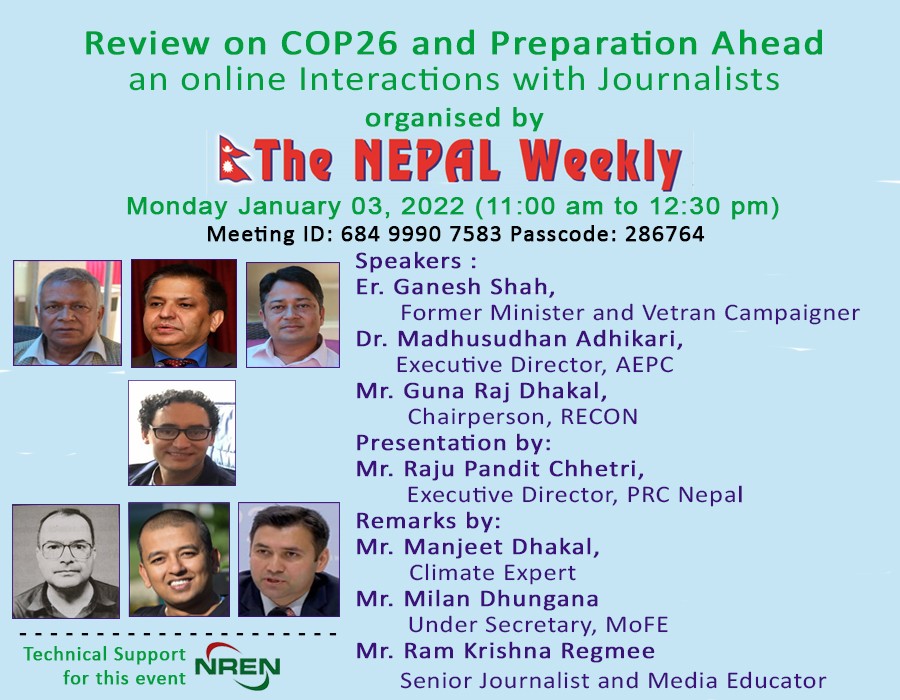 The Nepal Weekly
The Nepal Weekly  July 4, 2022
July 4, 2022
By Purna N. Ranjitkar l
Kathmandu Metropolitan City (KMC) is having a number of problems, such as waste management, squatters, street vendors, beggars, public transportation, parking spaces, open spaces, convenient stores, citizens’ medical facilities, air-pollution, preservation and restoration of religious monuments, cultural heritage, restoration of greenery, drinking water supply and many others.
Recently, the KMC security acted to manage footpaths for convenience of pedestrians by clearing the street vendors in some places. But, a section of ‘elites or accessed people’ objected the move asking the poor people doing business must not be disturbed. If, not the authorities have to provide them alternative – that may be a designed space for their street vending – or alternative for their livelihood.
On the other hand, the locals and pedestrians who suffer more by encroachment of street vendors say that street vendors should be managed well. Similarly, another argument is surfaced saying the government had widened roads by acquiring personal properties of locals and the street vendors are occupying it citing their livelihood. So the objectives of road widening has been turned to be giving space to such intentions is not acceptable. Therefore proper legal actions must be taken. Likewise, different associations linked to street vendors are somehow morally supported by human right activists. They argue that the street vendor should get space for their livelihood.
Newly elected Mayor Balen Shah has many commitments regarding well management of the KMC that include all as said above. The recent action to remove street vendors in some places generated mixed reactions – supporting KMC action vs supporting self-employed street vendors.
Street vending has been common practice in the Kathmandu Valley since a long time, specially the local farmers bring fresh vegetables, fruits and flowers from their fields out to sale the for local consumption. Besides that few other ready to eat items are sold in core places like Asan, Maru, Bhedasingh, Mangal Bazar, Lagankhel, Sukuldhoka, Taumadhi and so on.
Around Ratna Park, near the General Post Office, NAC are the places where street vendors are seen active. The western part and south-west part inside the BhrikutiMandap is also a big market place where vendors feel free.
The streets and walk-spaces have b een covered by such vendors who sale many items such as clothes, shoes, toys, electrical lights, emergency lights, watches, radios. Their target buyers are mostly of low income people who struggle to survive in the big cities. The vendors can catch their requirement easily as most of them are from the same social and economic background.
Around seven years ago, the street vendors were estimated to be around 10,000 while Nepal Street Vendors Trade Union (NEST) representative says that there were 30,000 street vendors in the Kathmandu Valley and more than 20,000 in the KMC at that time. One other organisation close to General Federation of Nepalese Trade Unions (GFONT) claims that there were around 35,000 street vendors in the Kathmandu Valley. This estimated figure of street vendors must have been doubled by now as we see more than double of the spaces have been covered in comparison to now and five years back.
The political forces behind them might be influential. The local government acts suggest that the KMC, Sub-Metropolitan Cities, Municipalities and Palikas have to provide ample space for weekly market event where the local growers can sale their products directly to the consumers or the merchants. The KMC also has to be able to allocate spaces to conduct weekly market place which may be commonly called haat bajaar. The open place of Tundikhel in front of Bir Hospital was once used as the market place for street vendors. The idea was soon uprooted by various forces. The relocation was thought for some other places but the street vendors and their leaders could find good place for their business to carry out. However, a few smart ones among them managed to get the space inside the Bhrikuti Mandap (west and south-west part as said above) which has been under authority of Social Service Coordination Council. The shops and godowns the vendors built there are quite unsafe. Any disaster like fire if caught the people and stuffs would get trapped without a hole to escape. The suffocation might be one other but big cause of losing many lives too. Therefore, some precaution should be worked out before getting into trouble. The stakeholders should be well aware of possible undesired incidents and learn preparedness.
Academic sector and intellectuals, in support of street vendors, stress that street vending is one of the key manifestations of urban poverty especially in developing countries like Nepal. Now it has become growing sector of smallscale economic activity due to lack of alternative source of income. Street vending is a simple way of income generation by investing small capital. Thus poor people are interested in such activities. In informal sector economic activities, street vendors are one of the most important parts. Street vending has been a global phenomenon. Yet today, in most countries of the world, street vending persists and probably has expanded even where local regulations seek to ban or restrict it. In the case of a least developed country (LDC) like Nepal, the formal sector is very small to provide job opportunity to the large number of labour force. Therefore, obviously a large portion of the people is engaged in the informal economy for their livelihood and such segment is considerable in the urban areas.

